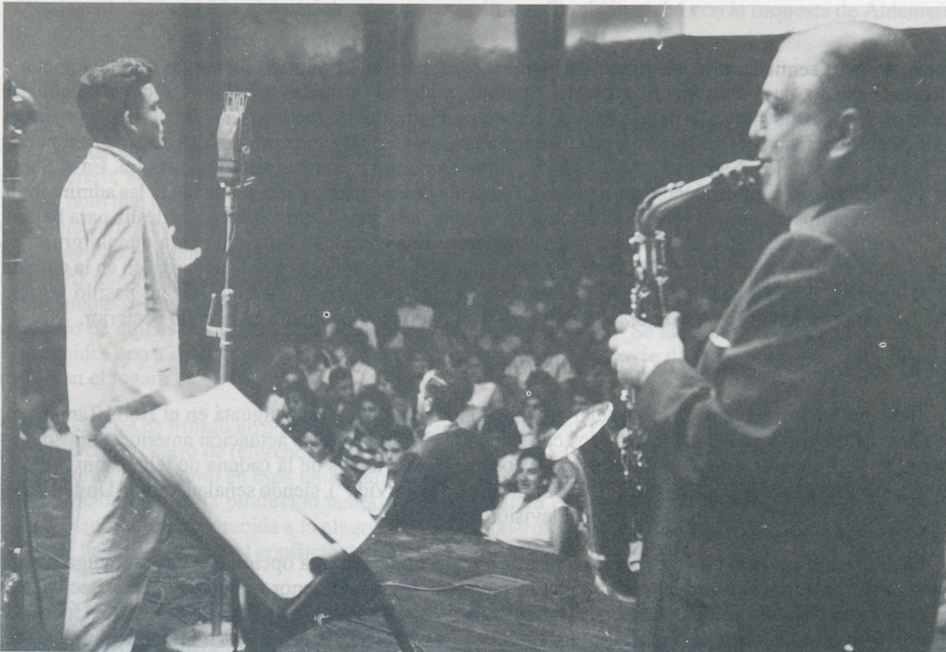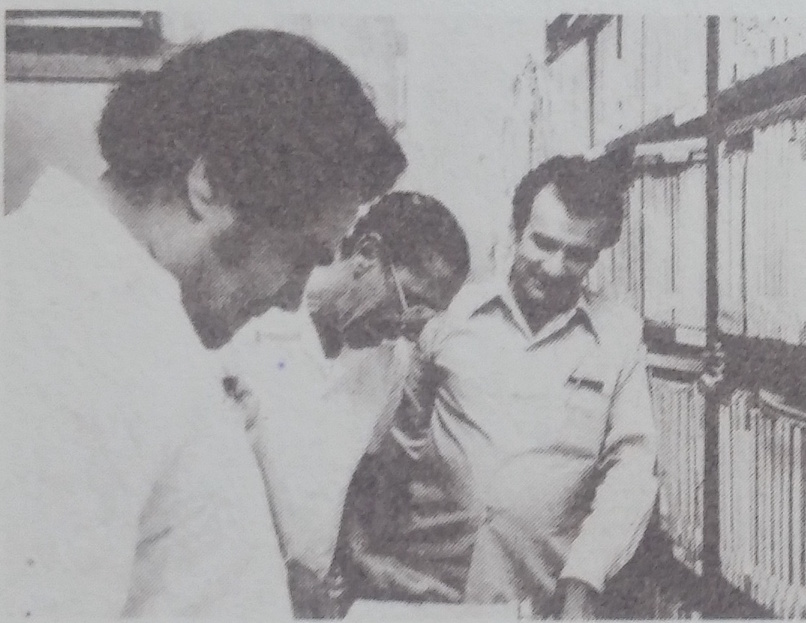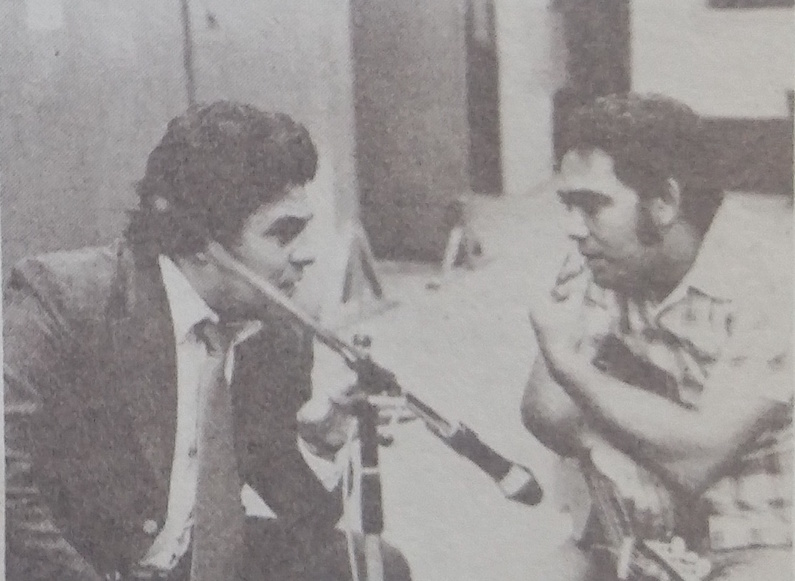Alfredo Sadel - En Cuba [BASF, 1978, LP]
The year is 1955. A young Venezuelan singer, just barely 25, thin, of medium stature, and with impeccable coiffed hair, arrives in Havana. This was the next stop in his tour of the Americas, after his enormous success in his native Venezuela where he recorded with the famous Billo's orchestra and in the first television programs in Radio Caracas Televisión, as well as his trip through the United States, employed by RCA Victor and accompanied by Aldemaro Romero's orchestra, ending up at the Ed Sullivan Show. A few months later, the whole of Cuba has fallen at his feet, giving him his own radio program in the most popular broadcaster on the island, and appearing on television with Benny Moré, one of the most renowned Cuban singers of all time. He sold so many of the records he recorded on this visit, and his music was so often played on the radio that the bus drivers, "yelled out when they reached the corner of Radio Progreso, with the intention of pointing out to the young ladies that filled the bus, "Ladies, you've arrived at Sadel Corner"." His popularity reached such a level that the street where CMQ, the largest Cuban broadcaster at the time, was located, was named after him: Alfredo Sadel.

Alfredo Sadel, recording live for broadcaster CMQ
Except for his native Venezuela, Alfredo Sadel never had nearly as much success as he did in Cuba. Over the next 3 years since his first visit, Sadel would continually return despite his engagements in Mexico and with MGM Studios in Hollywood, where he recorded as a replacement for the famous tenor Mario Lanza. As musicologist César Miguel Rondón chronicled: "he made records, performed on TV and his picture appears with high praise in almost all magazines and other publications of the island. His name is Alfredo Sadel, legitimate member of all the pomp and celebrity euphoria that passed through the Americas in those times." However, with the arrival of the Cuban revolution, Sadel distanced himself bit by bit from the island, with his last visit for a long time being in 1962, due to the great change in Cuban political conditions.
During this time, Sadel dedicates himself to bel canto, going on a world tour of operas and zarzuelas, including a tour through the Soviet Union in 1967-68, becoming the first Venezuelan to perform in Soviet opera. Despite his success now at a world level, Sadel never forgot the affection he had for his years in Cuba, a feeling that culminated in 1978 with a two week tour around Havana. Once again, he would make a record, perform in various theatres around the city, and it was as if the twenty-six years since his last visit had not passed: immediately Sadel was again surrounded by fans, some of whom had been the same ones who saw his first performances in the fifties, others younger that see him for the first time. The record I bring you today in this post is a testatement to the spirit that passed through the island in this tour - as César Miguel Rondón, who was present, reviewed: "Now it's your turn, thanks to the grooves in this record, to live some of the enthusiasm that characterized those two weeks in Havana."

Alfredo Sadel with Luis Yáñez, composer of "Indestructible" and Medardo Montero, director of EGREM. Photograph by César Miguel Rondón
This record is the meeting between the Cuba from before and after the revolution, both in the selection of tracks that, for example, put together the classic Lágrimas Negras composed by Matamoros with "Si el Poeta Eres Tú", the "nueva canción" composition by Pablo Milanés, as well as in the musicians that perform on the record: those of the old Cuba like the guiro player Gustavo Tamayo, violinist Pedro Hernández and drummer Guillermo García from the Orquesta Aragón, side-by-side with the rising stars of Cuban music in the seventies like pianist Chucho Valdés, arranger and trombone virtuoso Juan Pablo Torres, and Arturo Sandoval, trumpet player for the famous modern Cuban group Irakere. The combination of all this Cuban talent, old and new, and the voice of Sadel refined for over twenty years of operatic performances, result in one of the best available recordings of Alfredo Sadel out there. This record is a historical document not only for the life of Venezuela's favorite tenor, but also as a record of the transitional period of Cuban music, where the old guard of cabarets and big bands met with the vanguards of the "nueva canción", together for a week recording for Alfredo Sadel.

Alfredo Sadel and Juan Pablo Torres chatting during the recording sessions. Photograph by César Miguel Rondón
Liner Notes
Fortunately, this record comes with an exhaustive review of the tour from musicologist and journalist César Miguel Rondón, one of his earlier pieces, as he was twenty-five when he wrote these liner notes, just as Sadel did when he first visited Cuba.
Personnel
Accompanied by the EGREM Orchestra
Conductor: Tony Taño (1,2,4,5,6,8,9,10,11)
Juan Pablo Torres (3,7)
Arrangements: Tony Taño (1,2,5)
Juan Pablo Torres (3,7)
Rey Montesino (6,8,9)
Miguel Porcel (4)
Chucho Valdés (10)
Pedro Coto (11)
Alba Marina sings with Sadel in "Noche Azul"
Musical directon: Tony Taño
Producer: Orlando Montiel
Photographs: César Miguel Rondón
Graphic Design: Sigfredo Chacón
Printed in Editorial Arte, Caracas
Recorded in EGREM Studios, Havana, January/February 1978
Sound technician: Antonio López
Lacquer cut at Estudios Fidelis, Caracas
Pressed in Grabaciones Antor, Caracas
Co-produced by: Clara Posani (Venezuela), EGREM (Cuba) and yvkct con música (Venezuela)
Distributed by BASF VENEZOLANA S.A., Calle Milán, Edificio BASF, Los Ruices Sur, Telephone (02) 227222, Caracas, 107, Venezuela
Review, by César Miguel Rondón
1.
The year is 1958. A young Venezuelan, of stylized figure and good voice, is an idol in Havana. His popularity is rivaled only by Lucho Gatica, he made records, performed on TV and his picture appears with high praise in almost all magazines and other publications of the island. His name is Alfredo Sadel, legitimate member of all the pomp and celebrity euphoria that passed through the Americas in those times.
January 1978, the same Alfredo Sadel, now somewhat thicker built, with an absolute dominion of his voice thanks to his dedication to opera, returns to Havana. The itinerary seems identical: make a record, perform in TV and in some theaters on the island. The first big difference of this second tour is the anticipation: Cubans and Venezuelans both want to know what's going to happen, and Sadel feels strange, sufficiently excited about returning to Cuba. He knows that nostalgia is a good argument in favor of once again pleasing old Cubans, but he is also conscious that there is a whole generation that has never heard his voice. But it is this anticipation, precisely, that gives this new trip to the island a special touch: to Sadel and all those who have anything to do with this project it is therefore a challenge, and so it is approached.
From the very first day, the work begins. A meeting is organized in the offices of EGREM [editor's note: EGREM, Empresa de Grabaciones y Ediciones Musicales, is the Cuban national record label founded ain 1964 after the Cuban music industry was nationalized] to prepare the record. Present are the musicians, the arrangers, the producers, and Alfredo who says that this song is good and that one isn't quite his style. The desk of Medardo Montero (the director of the company) is full of records: there's a lot of old things, but also the new, the "nueva trova", a style of music that quickly takes over the general character of the record. Tony Taño, a Cuban musician and a certified professional, is the man who will direct the recordings. He distributes the arrangements - this one for Montesinos (the young director of the ICR orchestra [Instituto Cubano de Radiodifusión - Cuban Institute for Radio Broadcasting]), these for Juanito (Juan Pablo Torres, one of the most distinguished musicians of the modern Cuban musical expression, as well as an absolute virtuoso on the trombone), this one for Chucho (Chucho Valdés, Bebo's son, director of Irakere [editor's note: Grammy-winning Cuban band that pushed the boundaries of Afro-Cuban jazz around this time], recognized internationally among the five best pianists in the world), another for Coto (Pedro Coto, another pianist of the finest style, a natural heir of the best Cuban musicality), and the others for me (says Tony, for whom the Aragón owes him much of their new wave) [editor's note: Orquesta Aragón, famous and long-running Cuban orchestra begun in 1939, which passed through various directors and styles through its extensive history. Tony Taño was the musical director for EGREM since 1974, where the Orquesta Aragón recorded around those times]
2.
The musicians gave the work their all: recording started in two days and as such the arrangers needed to work against the clock. Alfredo, for his part, took the sheet music and a few casettes with the new music to his hotel room: he didn't know the new music, and to record it properly he needed to master it. Plus, it was stipulated that while the musicians recorded the backing tracks, Alfredo would have time for all his performances in the theaters and on TV. Sadel locked himself in the hotel, and to the surprise of everyone that's where one began to feel the tone of this Cuban tour, because the visits came continuously: old friends, journalists, simple admirers and old fans, now housewifes with experience, with the kids this big, that would bring him the old photo albums and scrapbooks, where Alfredo was thin, behind a CMQ microphone [editor's note: famous Cuban broadcaster of pre-revolutionary times], with a legend at the foot of the picture saying: "yo soy un negrito fino con mucha ciricutancia..." [editor's note: this is a reference to the first line of one of Sadel's hit songs in Cuba, "El Cumaco"] Someone, in the middle of the bustle, commented that the tickets to the first performance in the Karl Marx theater (formerly the Blanquita theater) were sold out. And that, in effect, was the tone of the tour.
On the other side of the city, in the EGREM studios, recording for the base tracks (as the Cubans call them) began. There in the studio, musicians of every era of Cuban music met, characters that have been a legend in one or another of those old-timey orchestras, timid youngsters, some of them callow, whose virtuosity was put ahead of whatever negative comments came by. There was, for example, Gustavo Tamayo, the guiro player from those fabulous descargas of the fifties, there was Pedro Hernández, [editor's note: famous violinist in the old Radio Progreso, as well as in cabarets "Rumba Palace", "El Niche" and "Montmartre"] violinist of fine lineage that could not stand retirement and returned to continue playing music (a master of danzón, he was the man who arranged the record of Barbarito Diez, who with Venezuelan music so much success has had in our countries), there was also Guillermo, the tumbador for Orquesta Aragón, Varona on the trumpet, [editor's note: Jorge Varona, who played in Benny Moré's Banda Gigante as well as in the Orquesta Cubana de Música Moderna and later in Irakere]* and so many others that exhibited a good dose of white hair and experience sitting there in the strings section. But there were also the youngsters: Chucho in the piano for which the very Brubeck [Dave Brubeck, pianist and composer of the famous standard "Take Five"] considered him among the best; also from Irakere Arturo Sandoval as lead trumpet, another of the best in the world with his instrument; Fabián on the bass (from Jorrín's orchestra to the Orquesta Experimental de Música Moderna); [editor's note: this is Fabián García, famed bassist showcased in the Estrellas de Areito series ] and the guitarist, who during the breaks took advantage of the time to talk about modern jazz: George Benson and the like. The orchestra was definitely a true "All Stars".
While they recorded, Alfredo went to his first performance at the Karl Marx. He appeared as an invited star in the lavish show of Rosita Fornés. [editor's note: One of the most famous actresses of Cuban theater, founder of the group National Lyric Theater] He composed his repertoire based on his hits from twenty years ago: Marqueti's "Deuda", "Tu No Comprendes" from Rafael Hernandez (the Puerto Rican composer for whom Sadel has a special admiration in his heart), "Maria de la O" from Lecuona, the Venezuelan potpourri that transformed him into an idol during the time of the old "pepitas"; "Barlovento-El Cumaco de San Juan" and, finally, "Granada" from Agustín Lara where Sadel, taking advantage of all the natural power of his voice, extracted ovations in the middle of the song. It was an absolute success, and that was how Granma [editor's note: Granma is the official newspaper of the Cuban Communist Party] reviewed it the following day. In the next performance, euphoria manifested itself through the audience from the moment that Fornés gave him the microphone. And on the third day the emotions were so powerful that it felt as if those twenty years really hadn't passed, that this was still the first time that Sadel had come to the island to become an idol, that the "pepitas", though now with grown children, were still the same.
When Alfredo performed on television, he expanded his repertoire. In 1958 he recorded "Alma Libre" in a duet with Benny Moré, and that spirit had to be revived as well. And so television provided the environment, Pacho Alonso put forth his orchestra and he himself was in charge of making a duet with Sadel. [editor's note: Pacho Alonso was one of the most famous singers and bandleaders of pre-revolution Cuba, along with Benny Moré and La Lupe. Pacho would continue as both bandleader and singer in Cuba until his death in 1982. ] By this time, everyone was commenting that the Venezuelan had again taken over Havana.
3.
After the euphoria of the theaters, it was time for seclusion in the studios. All the "bases" were ready and now Alfredo needed to add his voice. The recordings began at 10 PM, there was enough coffee and many ham and cheese "bocadillos". Sadel was the first to decide: first the old ones, I know them better. And so, little by little, the legendary "Lágrimas Negras" composed by Matamoros began to take form, according to the new arrangement that Juanito had conceived. Then came "Noche Azul" and "Si me Pudieras Querer" where Coto, in the arrangement, made the piano stand out a little more so that the tribute to its creator - Ignacio Villa (the great Bola de Nieve) - was complete. [editor's note: Bola de Nieve died in 1971] In the subsequent sessions, the challenge to face was the new Cuba, the music of Pablito Milanés, Silvio Rodríguez and Amaury Pérez: the definitive touch so that this return twenty years later would be truly important. Progressively, Alfredo's voice was collecting these poems together with music: "Si el Poeta Eres Tú", "Para Vivir", "Te Doy Una Canción", "Vuela Pena" and "Acuérdate de Abril". The record now had shape, the project was completed.
Finally, the song that Alfredo composed was recorded, "a song to thank you all, to manifest the respect I have for this people", as he said in one of the sessions. The music was composed by Juan Pablo Torres and originally was much faster. One Sunday afternoon, Juanito with the guitar and Alfredo with the piano, worked the melody out until they brought it down the path that they wanted. Later Sadel, locked in the hotel, gave it the lyrics that you listen to now.
The tour, gentlemen, has concluded.
4.
In the world of popular music, the persistence of one singer, more than the prefabricated ups and downs of fashions, is determined by the immense quantity of memories that this music and its performer can bring forth in their audience. Because of this, Alfredo Sadel again had success in Cuba, because the audience could recognize in this Venezuelan singer all the quality that presumes good music and better performance. "Now he sings better than before" said the Cuban press, and that is rigurously true. Now it's your turn, thanks to the grooves in this record, to live some of the enthusiasm that characterized those two weeks in Havana. In truth, the tango was right: "veinte años no es nada", [editor's note: this is a reference to the tango "Volver" by Carlos Gardel, one of the legends of tango] both the old and the new generation identified with him as people, deep down, are the same; it only takes a singer to remind them and Alfredo Sadel did so.
Track List and Rip
In my opinion, this is an unforgettable record, and I hope you all have as much of an appreciation for it as I have.
Normally when I write these sections I lay out the "A" and the "B" sides so that you can know how the record was structured. However, this time around the "Personnel" section refers to all the pieces as numbers ignoring the sides, so I left them as numbers so you can follow that section better.
- Te doy una canción (Silvio Rodriguez)
- Si el poeta eres tú (Pablo Milanés)
- Lágrimas negras (Miguel Matamoros)
- Acuérdate de Abril (Amaury Pérez)
- Para vivir (Pablo Milanés)
- Pobre del cantor (Pablo Milanés)
- Te quiero merecer (Juan Pablo Torres y Alfredo Sadel)
- Noche azul (Ernesto Lecuona)
- Vuela pena (Amaury Pérez)
- Indestructible (Chucho Valdés y Luis Yáñez)
- Si me pudieras querer (Ignacio Villa, Bola de Nieve)
Download the rip: here